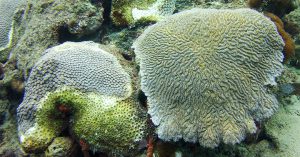
Since 2014, the Florida Reef Tract has experienced a prolonged coral disease outbreak. This is of grave importance, as the 350 linear mile-long reef system is the largest barrier reef in the continental United States, and the third largest barrier reef in the world. This sensitive ecosystem is already stressed, trying to recover from back-to-back bleaching events in 2014 and 2015, continuous coastal development, warming ocean temperatures, water quality issues, and physical impacts from boating and marine debris.
The first wave of the disease outbreak passed through the northernmost section of the reef tract from the St. Lucie inlet south through Biscayne National Park and the northern Florida Keys from 2014-late 2016. This ailment presents itself as a white band that appears to kill the living coral tissue, leaving behind bare skeleton that is quickly colonized by turf algae. Referred to as “white plague,” this disease could kill an entire coral colony in as little as two weeks. More than 20 species of corals (almost half of Florida’s reef-building species) have been affected by the white plague syndrome, including:
- Blushing Star Coral

White plague disease affects three colonies of Great Star Coral. Photo: Ana Zangroniz - Boulder Brain Coral
- Elliptical Star Coral
- Finger Coral
- Great Star Coral
- Grooved Brain Coral
- Knobby Brain Coral
- Lettuce Coral
- Lobed Star Coral
- Massive Starlet Coral
- Maze Coral
- Mountainous Star Coral
- Mustard Hill Coral
- Pillar Coral
- Rough Cactus Coral
- Smooth Flower Coral
- Smooth Star Coral
- Symmetrical Brain Coral
Pillar coral is listed under the Endangered Species Act with a “threatened” status. 99% of the known living colonies of pillar coral in the northernmost section of the reef tract have suffered 100% mortality. A rescue effort is underway for this species, which means that scientists have collected living fragments of this coral to cultivate in labs to try and preserve the species.
Coral disease is present in any coral ecosystem, but an outbreak of this extent is a rare event. Currently, the disease has crossed into the lower Florida Keys including Looe Key, one of the most prized areas within the Florida Key National Marine Sanctuary. Additionally, observations of a different, tissue loss disease have been reported throughout locations in the Caribbean. In addition to the white plague epidemic, this latest outbreak has been a mystery to scientists, managers, and researchers, as it is unclear whether the diseases are viral or bacterial, or what the possible pathogen could be.
Since the start of the outbreak a large, multi-agency partnership has been organized to determine the extent of the outbreak, perform disease monitoring, and perform research on potential quarantine methods and anti-biotic treatments. These efforts will continue for the foreseeable future.
Here are things you can do to minimize your impact and help control the further spread of the outbreak:
If swimming, snorkeling or diving:
- Minimize sunscreen use or wear reef-safe sunscreen or other skin protection, like a rashguard
- Take care not to touch, kick, or otherwise disturb corals
- Between dive trips, disinfect all dive gear with Odoban Disinfectant, available at Home Depot
- Report any signs of coral disease to SEAFAN or C-OCEAN
If on land:
- Take care with what items are poured down the drain
- Dispose of oils or other chemicals appropriately
- Try to minimize fertilizer use during the wet season
- Make sure that your rain gutters are positioned over grass
- Use low flow toilets and appliances
- Wash your car over grassy areas
- If on a septic system, make sure it’s maintained regularly
 0
0

